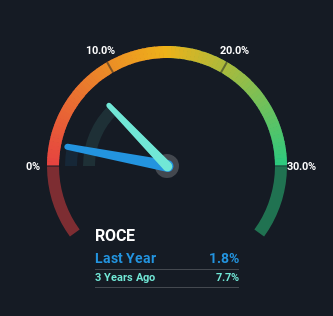- China
- /
- Semiconductors
- /
- SHSE:603986
Giga Device Semiconductor (SHSE:603986) May Have Issues Allocating Its Capital

What trends should we look for it we want to identify stocks that can multiply in value over the long term? Amongst other things, we'll want to see two things; firstly, a growing return on capital employed (ROCE) and secondly, an expansion in the company's amount of capital employed. If you see this, it typically means it's a company with a great business model and plenty of profitable reinvestment opportunities. Although, when we looked at Giga Device Semiconductor (SHSE:603986), it didn't seem to tick all of these boxes.
What Is Return On Capital Employed (ROCE)?
For those who don't know, ROCE is a measure of a company's yearly pre-tax profit (its return), relative to the capital employed in the business. The formula for this calculation on Giga Device Semiconductor is:
Return on Capital Employed = Earnings Before Interest and Tax (EBIT) ÷ (Total Assets - Current Liabilities)
0.018 = CN¥289m ÷ (CN¥17b - CN¥1.1b) (Based on the trailing twelve months to September 2023).
Therefore, Giga Device Semiconductor has an ROCE of 1.8%. In absolute terms, that's a low return and it also under-performs the Semiconductor industry average of 5.8%.
Check out our latest analysis for Giga Device Semiconductor

Above you can see how the current ROCE for Giga Device Semiconductor compares to its prior returns on capital, but there's only so much you can tell from the past. If you'd like to see what analysts are forecasting going forward, you should check out our free analyst report for Giga Device Semiconductor .
What Can We Tell From Giga Device Semiconductor's ROCE Trend?
In terms of Giga Device Semiconductor's historical ROCE movements, the trend isn't fantastic. Over the last five years, returns on capital have decreased to 1.8% from 17% five years ago. Given the business is employing more capital while revenue has slipped, this is a bit concerning. If this were to continue, you might be looking at a company that is trying to reinvest for growth but is actually losing market share since sales haven't increased.
On a side note, Giga Device Semiconductor has done well to pay down its current liabilities to 6.7% of total assets. That could partly explain why the ROCE has dropped. Effectively this means their suppliers or short-term creditors are funding less of the business, which reduces some elements of risk. Since the business is basically funding more of its operations with it's own money, you could argue this has made the business less efficient at generating ROCE.
The Bottom Line On Giga Device Semiconductor's ROCE
From the above analysis, we find it rather worrisome that returns on capital and sales for Giga Device Semiconductor have fallen, meanwhile the business is employing more capital than it was five years ago. In spite of that, the stock has delivered a 31% return to shareholders who held over the last five years. Regardless, we don't like the trends as they are and if they persist, we think you might find better investments elsewhere.
One more thing to note, we've identified 3 warning signs with Giga Device Semiconductor and understanding them should be part of your investment process.
While Giga Device Semiconductor isn't earning the highest return, check out this free list of companies that are earning high returns on equity with solid balance sheets.
New: Manage All Your Stock Portfolios in One Place
We've created the ultimate portfolio companion for stock investors, and it's free.
• Connect an unlimited number of Portfolios and see your total in one currency
• Be alerted to new Warning Signs or Risks via email or mobile
• Track the Fair Value of your stocks
Have feedback on this article? Concerned about the content? Get in touch with us directly. Alternatively, email editorial-team (at) simplywallst.com.
This article by Simply Wall St is general in nature. We provide commentary based on historical data and analyst forecasts only using an unbiased methodology and our articles are not intended to be financial advice. It does not constitute a recommendation to buy or sell any stock, and does not take account of your objectives, or your financial situation. We aim to bring you long-term focused analysis driven by fundamental data. Note that our analysis may not factor in the latest price-sensitive company announcements or qualitative material. Simply Wall St has no position in any stocks mentioned.
About SHSE:603986
Giga Device Semiconductor
A fabless company, provides engages in the research and development, technical support, and sales of memories, microcontrollers, and sensors.
High growth potential with excellent balance sheet.


